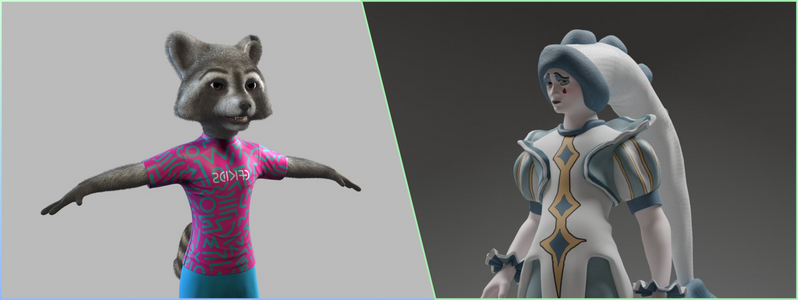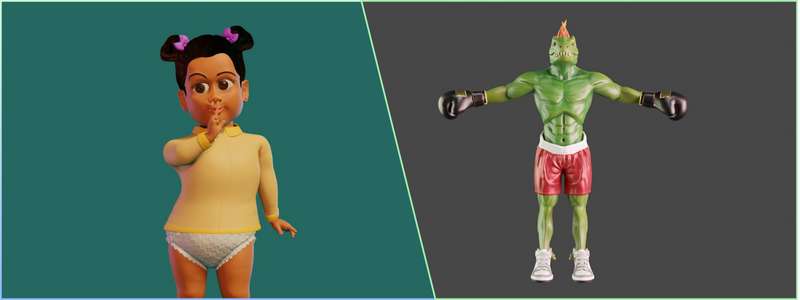This article covers tips and insights for firms when hiring 3D character modeling services. Video games would be dull without an environment. But character development is also crucial for a game to be fully complete. Without proper development and arc of characters, a game can never be considered a game in the first place. Players identify with the characters in a game, allowing players to engage better with the overall gameplay.
Characters that portray emotions that resemble those felt in real life evoke sympathy among players. This sympathy creates emotional attachments and attracts the audience to the game. The minor details are essential when developing 3D characters and 3D character animation. This blog provides a 3D character modeling guide that tackles the creation process, tips, and insights for companies.
 Table of Contents
Table of Contents
RELATED: 3D character modeling and design process: top tips for your company or business
3D character modeling and its role in game development
As a manifold process, 3D character modeling is where the 3D character rigging and animation designer uses different software and tools to develop game characters. 3D characters can be a person, robot, mythical creature, animal, devil, or anything imaginable. They can also be the primary protagonists or antagonists that players control during gameplay.
Secondary characters are those with an individual impact or act as supporting characters in the game that the players interact with. The process of creating 3D character models starts with developing their primitive form. For example, a 3D character modeling designer can form a square or cube shape, use different software and tools to modify or alter it, and further edit the 3D model using other programs.
Popular styles of 3D character modeling for game characters
Most people who play games or watch animated videos don’t consider the effort and hard work that goes into their development. Creating 3D character models requires careful planning, a suitable skillset, and lots of time. 3D artists generally develop 3D human models for primary and secondary characters. The styles of characters are based on the goals and settings of the game. There are several prominent styles of playable characters, including cartoon, fantasy realism, and realism. Here is a quick overview of these styles to help you identify the right one that will help you reach your goals.
RELATED: How much does a 3D character modeling service cost for 3D artists & firms?
Cartoon
Cartoony video games are prevalent among kids and teens alike. Regarding graphics, 3D modeling design companies using this 3D art style make them look more bright and colorful. As its name implies, these characters are also cartoony. But even more striking is that cartoony characters are also well-loved among adults because of their simplicity and the fact that they also come in handy for educational content. Cartoon-style games offer a non-realistic gaming style with strategic gameplay and a unique environment.
Fantasy realism
Fantasy realism has the characteristics and qualities of a realism art style. The only difference is that the animations and graphics aren’t taken from real life. Despite the realistic appearance of the graphics, the 3D character modeling designers use the fantasy style to develop a realistic game. 3D character modeling designers must have excellent imaginative skills to develop 3D game character designs in this art style. Again, the difference between fantasy realism and realism is that the game may look like reality in the setting of the game, but it is fictitious.
RELATED: 5 CAD designs from imaginary worlds
Realism
Realism is about recreating the world as people see it in real life in 3D digital form. This doesn’t mean realism depends on the highest processing power to mimic human faces and other items. Realistic graphics are instead about creating a realistic environment based on reality. 3D character modeling in realism has captured the amusement of many users and continues to do so.

The creation process of 3D character models
The initial planning stage of any project is critical, and it is vital to be familiar with the creation process of 3D character models to ensure a smooth and seamless concept and vision of the game. Here is a quick overview of the steps involved in developing 3D character models:
Concept
Before creating a 3D character model, you should understand their story and connection with the rest of the characters, game plots, and environments. Take time to visualize the 3D character model and gather as many references as possible to understand how you will develop it. Consider the character’s background details to create a perfectly unique character.
RELATED: A guide to 3D virtual reality animation rendering services for companies and firms
Blocking
The next step in 3D character modeling is to combine the primitive shapes into your 3D character’s desired form. For this, you can use several cylindrical and cubical shapes and connect these elements of the character model to give you a clear idea of the character’s appearance.
Sculpting
During sculpting, you will have a smooth model that doesn’t have features, traits, and characteristics just yet. 3D character sculpting services create these using sculpting processes like clay modeling. For example, a sphere is used for the eyes of the character as well as to make the cheekbones and chin. Meanwhile, a long cylinder is applied to create a finger.
RELATED: 3D rigging design animations, 3D model & 3D rigging services explained for companies
Topology
The topology of a 3D game character is the surface structure that determines its visual characteristics. This is employed to develop the smaller details, including the hair, eyes, nose, and mouth. The appropriate topology is required for animating the individual parts of a 3D character model. 3D character model topology is traditionally made using polygonal modeling. Since polygons have several corners, it’s essential to choose a shape that allows effortless animation and editing of the individual parts of the character.
Rigging and skinning
Rigging refers to developing a character skeleton that is critical to individually animate the bones or skeleton to make the 3D character model move. The 3D rigging design firm often uses specialized software with readymade skeleton samples to 3D model the characters and other assets. The post-rigging process also involves skinning or the development of Bipedal characters for securing the model and skeleton surface. At this point, the skeleton becomes part of the character and can also move.
RELATED: Applications of 3D rigging services within the animation, film, and gaming industries
3D Rendering
With 3D visualization services, the 3D game artist crafts a scene through computer graphics for the 3D model, subsequently translating it into a 2D image. The artist will also fine-tune the camera direction, frame texture, and image lighting. The images are mainly used for advertising or promotional purposes.
Animation
Animation is the final and most crucial step in creating 3D character models. Here, the 3D character artist will animate the character’s body movements and create facial expressions to bring the characters to life. Most 3D services use state-of-the-art technologies and tools to manipulate individual body parts while working on gestures, movements, and facial expressions.
RELATED: What is 3D rigging and how is it used for 3D character animation?
Why outsource 3D character modeling
It is not a secret that some game companies lack a team of competent and experienced 3D character animation experts and artists who can create top-notch art. This is why delegating this to professionals specializing in 3D character models is critical. One of the top benefits of outsourcing the task is that you can get a complete game design and art solution, with everything done by a single professional team under one roof. Here are other reasons to outsource your 3D character modeling projects:

Speed up art creation
3D character modeling services are helpful when you lack the time and resources to finish your project on time. Trusted service providers can speed up the process by providing on-demand services from professionals with extensive field experience.
RELATED: 3D Rigging and 3D rig services, costs, rates, and pricing for companies and firms
Take advantage of niche expertise
Choosing an expert 3D character modeling company enables you to select the 3D character modeling designers and developers to match the project. Working with a well-known company will instantly boost your available expertise.
Improve the creativity of your team
Numerous 3D character modeling services engage in a wide range of projects across diverse genres, demonstrating a willingness to contribute their expertise and innovative ideas to enhance the quality of your game, ultimately positioning it as a standout in the market.
Make artistic and creative content
A team of 3D character modeling designers can highlight your game, among others, whatever genre you choose. If you like, they can even develop a whole new genre for the project that will impress and blow away your target audience.
RELATED: Metaverse gaming design: how it works, and what it means for companies and businesses
How Cad Crowd can help
Suppose you need assistance with your 3D character modeling projects. In that case, Cad Crowd can connect you with the top professionals who can create the best and most mind-blowing 3D characters and 3D character animations you can imagine.
